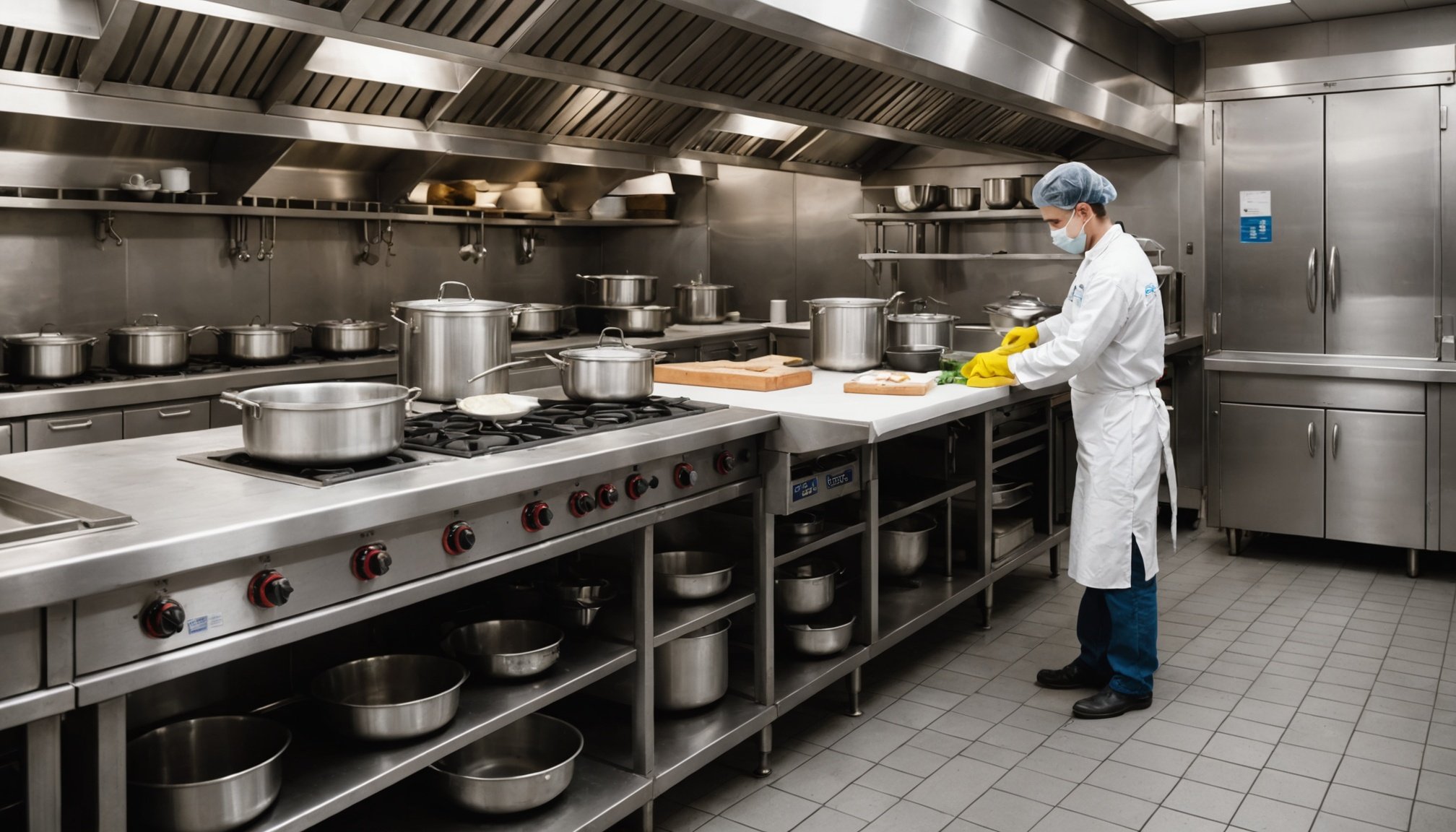Managing chemical cleaning agents in restaurant kitchens demands a rigorous approach to safety. The potential hazards of these substances can threaten staff health and pose risks to food safety. Implementing essential safety measures is not just a legal obligation; it is vital for creating a safe working environment. This guide outlines effective strategies for safely handling these chemicals, ensuring that kitchen staff remain protected while maintaining the highest hygiene standards. Equip your team with the knowledge to manage cleaning agents responsibly and safeguard both their well-being and the integrity of your restaurant.
Overview of Chemical Cleaning Agents in Restaurant Kitchens
Understanding the role of chemical cleaning agents in maintaining restaurant kitchen safety is crucial. These agents are indispensable for ensuring cleanliness and hygiene, but their use requires careful attention to prevent accidents.
Also read : Essential Tips for Designing a Captivating Sensory Garden Dining Experience at Your Rural Bistro
Types of Chemical Cleaning Agents
In restaurant kitchens, various chemical cleaning agents are commonly used. These include:
- Degreasers: Essential for removing grease from kitchen surfaces.
- Sanitizers: Used to eliminate bacteria and other pathogens.
- Detergents: Help in breaking down food residues and dirt.
- Disinfectants: Vital for killing viruses and ensuring a sterile environment.
Importance of Safe Handling
The safe handling of chemical cleaning agents is paramount. Proper training and adherence to safety protocols can significantly reduce the risk of accidents, such as chemical burns or inhalation hazards. Ensuring staff are well-informed about the correct usage of these agents is a key aspect of maintaining a safe kitchen environment.
Additional reading : Essential Considerations for Sourcing Sustainable Seafood for Your Restaurant Menu
Regulatory Compliance
Compliance with regulations regarding the use of chemical cleaning agents is not just a legal requirement but a critical component of restaurant kitchen safety. Regulations often dictate the types of chemicals that can be used, storage requirements, and disposal methods. Adhering to these guidelines helps in preventing contamination and ensuring a safe dining experience for customers.
Essential Safety Measures for Handling Chemical Cleaning Agents
Ensuring the safe handling of chemical cleaning agents is crucial in preventing accidents in restaurant kitchens. Proper procedures must be followed to minimize chemical exposure and maintain a safe working environment.
Safe Mixing and Application
Mixing and applying cleaning agents requires precision. Always follow manufacturer instructions and wear appropriate personal protective equipment (PPE) such as gloves and goggles. Avoid mixing different chemicals, as this can lead to hazardous reactions.
Proper Labeling and Storage
Proper labeling and storage are vital in preventing chemical exposure. Ensure all containers are clearly labeled with the contents and hazard information. Store chemicals in a designated area, away from food and heat sources, to prevent accidental spills or contamination.
Staff Training on Safety Protocols
Training staff on safety protocols is essential for effective chemical exposure prevention. Regular training sessions should cover the correct use of cleaning agents, emergency procedures, and the importance of PPE. Encourage employees to report any safety concerns immediately.
Key Steps for Safe Handling:
- Wear PPE at all times
- Follow mixing instructions carefully
- Label and store chemicals properly
- Conduct regular training sessions
By implementing these measures, restaurants can effectively manage the risks associated with chemical cleaning agents.
Best Practices for Storage of Chemical Cleaning Agents
Ensuring safe storage of chemical cleaning agents is critical for maintaining a secure kitchen environment.
Ideal Storage Conditions
Chemical storage guidelines emphasize the need for specific conditions to ensure safety. Store cleaning agents in a cool, dry place, away from direct sunlight and heat sources. This prevents degradation and potential hazards. Always use containers that are resistant to corrosion and clearly labeled.
Importance of Segregating Chemicals
Segregating chemicals is crucial to prevent dangerous reactions. Safety storage practices recommend keeping acids and alkalis separate. This minimizes the risk of accidental mixing, which can lead to hazardous situations. Use dedicated shelving for different categories of cleaning agents to enhance safety.
Regular Inspection and Maintenance
Routine inspection and maintenance of storage areas are vital. Ensure that all storage facilities are in good condition and free from leaks. Regularly check that hazardous materials management protocols are being followed.
- Checklist for Safe Storage:
- Ensure proper labeling
- Maintain optimal temperature
- Conduct regular inspections
- Segregate incompatible chemicals
By adhering to these chemical storage guidelines, kitchens can effectively manage risks and maintain a safe environment. Proper hazardous materials management is not only a regulatory requirement but also a best practice for safety.
Personal Protective Equipment (PPE) Recommendations
Ensuring safety through proper gear is essential in handling chemical cleaning agents.
Types of PPE Necessary for Handling Chemical Cleaning Agents
When dealing with chemical cleaning agents, wearing the right personal protective equipment (PPE) is crucial. Essential PPE includes gloves, goggles, and aprons. Gloves protect the skin from harmful substances, while goggles shield the eyes from splashes. Aprons provide an additional barrier for the body.
Guidelines for Proper Usage and Maintenance of PPE
Proper usage and maintenance of PPE for cleaning ensure its effectiveness. Regularly inspect gear for damage or wear and replace it as needed. Clean and store PPE according to manufacturer instructions to prolong its lifespan.
- Checklist for PPE Maintenance:
- Inspect for damage before use
- Clean after each use
- Store in a dry, safe place
Training Staff on the Importance of Wearing Appropriate Gear
Training staff on the importance of safety gear is vital. Employees should understand the risks of not using PPE and be encouraged to wear it consistently. Regular training sessions should highlight the correct usage and maintenance of PPE for cleaning.
By implementing these practices, restaurants can enhance safety and reduce the risk of accidents associated with chemical cleaning agents.
Emergency Procedures for Chemical Incidents
Effective response plans are crucial in managing chemical emergencies.
Steps to Take in the Event of a Chemical Spill or Exposure
When a chemical spill occurs, immediate action is essential. First, evacuate the area to prevent further chemical exposure. Next, alert trained personnel to manage the spill. Use appropriate personal protective equipment (PPE) and follow the specific chemical spill response protocol. Secure the spill area to prevent contamination.
Importance of Having an Emergency Response Plan in Place
An emergency response plan is vital for effective incident management. It outlines procedures for dealing with spills and exposures. Regularly update and review this plan to ensure it meets current safety standards. A comprehensive plan minimizes risks and ensures swift action during emergencies.
Regular Drills and Training for Staff on Emergency Procedures
Frequent drills and training are crucial for preparedness. Conducting regular exercises familiarizes staff with emergency response plans. These drills improve reaction times and reinforce the importance of safety protocols. Ensure that all employees understand their roles in a chemical spill response.
- Key Elements of an Emergency Plan:
- Clear evacuation routes
- Designated response team
- Regular training sessions
By implementing these strategies, restaurants can effectively manage chemical incidents, ensuring the safety of both staff and patrons.
Relevant Regulations and Compliance Standards
Adhering to regulations is crucial for maintaining chemical safety in restaurant kitchens.
Overview of OSHA and EPA Regulations
The Occupational Safety and Health Administration (OSHA) and the Environmental Protection Agency (EPA) set forth stringent chemical safety regulations to ensure workplace safety and environmental protection. OSHA focuses on reducing workplace hazards, while the EPA regulates the environmental impact of chemicals. Compliance with these standards is essential for legal operation and safety assurance.
Importance of Staying Updated
Keeping up with updates in safety regulations is vital. Regulations evolve to address new risks and technologies, so staying informed is crucial for maintaining compliance. Regularly reviewing updates ensures that your practices align with current health and safety laws. This proactive approach can prevent costly fines and enhance workplace safety.
Case Studies: Compliance Successes and Failures
Examining real-world examples can highlight the importance of adherence to compliance standards. Successful cases often involve rigorous training and regular audits, while failures frequently stem from neglecting updates or inadequate safety measures. Learning from these examples can guide effective implementation of chemical safety regulations.
- Key Compliance Elements:
- Regular training sessions
- Routine safety audits
- Staying informed on regulatory updates
By understanding and applying these compliance standards, restaurants can ensure safety and legal conformity.











